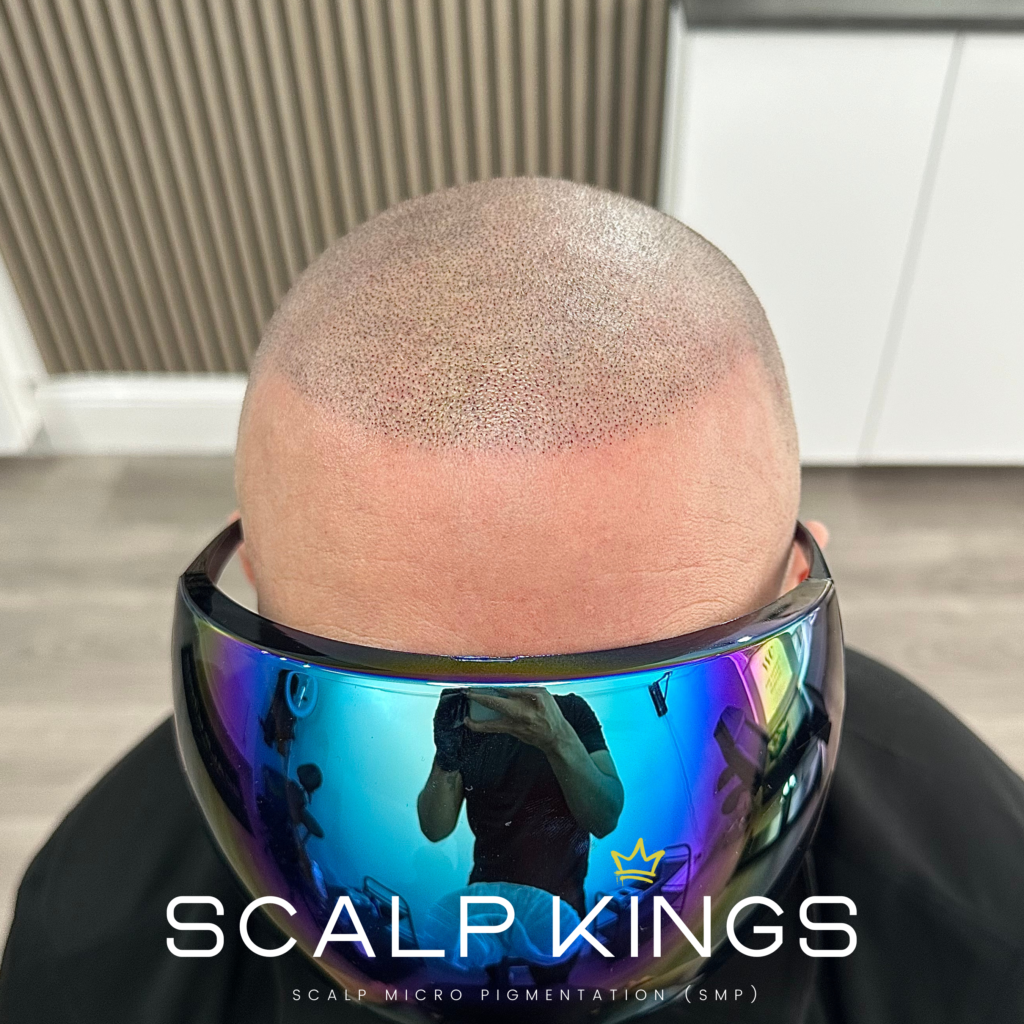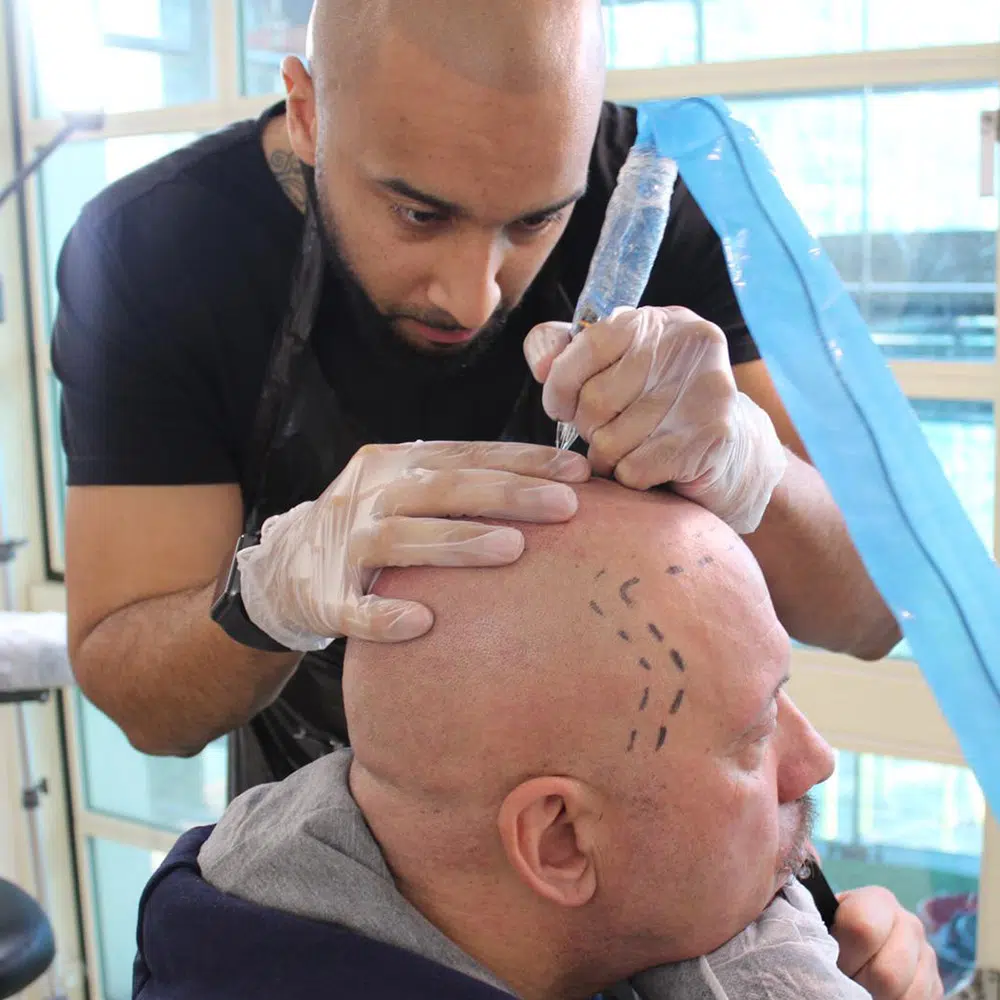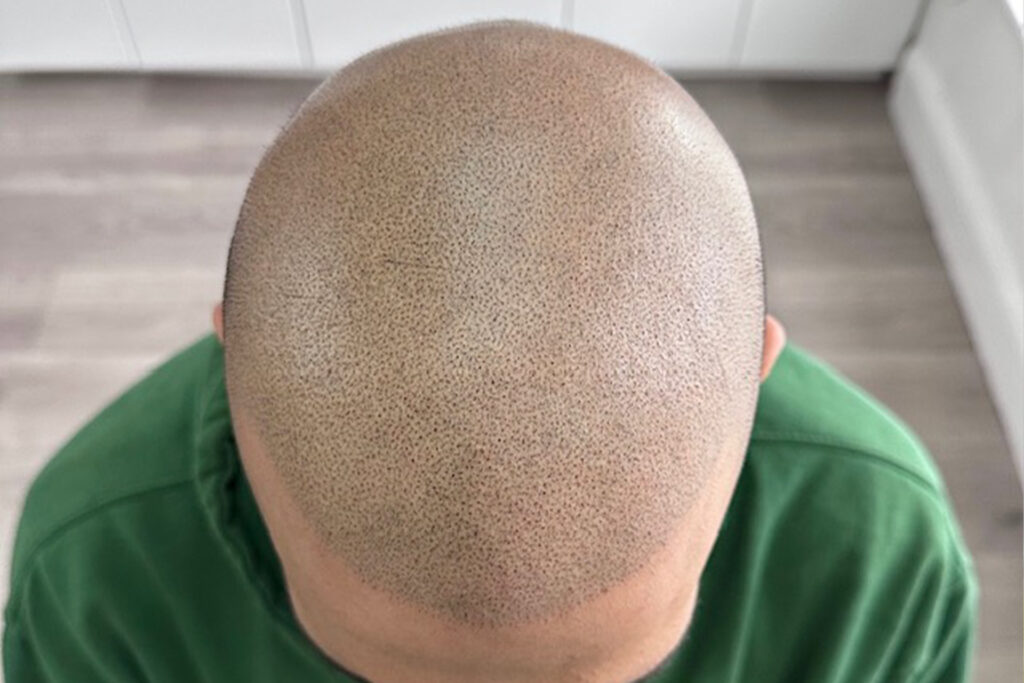Home / News
Does Scalp Micropigmentation Hurt?
If your hair is thinning, you’re probably considering trying scalp micropigmentation. But you might be nervous to follow through with the procedure because you’re nervous it will hurt. Unfortunately, scalp micropigmentation pain is subjective, so there’s no one way to answer this question. However, we’ll give you the best idea of what scalp micropigmentation pain is like in this guide.
Does Scalp Micropigmentation Hurt?
In short...
- Pain during Scalp Micropigmentation (SMP) varies greatly between individuals, influenced by factors like age, gender, genetics, and personal pain threshold — especially since the scalp is a sensitive area.
- Different areas of the scalp react differently, with zones closer to the face being more sensitive; however, discomfort often lessens as the session progresses and the body adjusts.
- Stress and anxiety can significantly increase perceived pain, making relaxation and mental preparation important for a more comfortable SMP experience.


Understanding the Factors That Influence Scalp Micropigmentation Pain
If you’re considering Scalp Micropigmentation (SMP), one of the first questions that probably comes to mind is: “Will it hurt?” The answer isn’t one-size-fits-all. While SMP is generally considered a low-pain or mild-discomfort procedure, your personal experience will depend on several individual factors. Understanding what influences pain perception can help ease anxiety and better prepare you for the process.
1. Your Personal Pain Threshold
Everyone has a unique pain threshold — the point at which a sensation becomes painful. This threshold is shaped by a combination of biological and psychological factors, including:
Age – Younger individuals may experience sharper sensations, while older clients often report less sensitivity.
Gender – Research suggests that men and women may perceive and tolerate pain differently due to hormonal and neurological differences.
Genetics – Some people are simply more sensitive to pain due to inherited traits.
- Previous experiences – If you’ve had tattoos before or undergone cosmetic treatments, you may already have a sense of how your body reacts.
In general, SMP is far less invasive than traditional tattoos. The pigments are deposited into the upper dermis with tiny, specialised needles — not as deep as traditional body ink, which reduces overall discomfort.


2. Different Areas of the Scalp = Different Sensations
Not all parts of your scalp will feel the same during SMP. Some regions are more sensitive than others due to skin thickness, nerve concentration, and proximity to the bone. Here's a quick guide:
More Sensitive Areas: Hairline, temples, sides of the head, and frontal scalp.
Less Sensitive Areas: Crown, mid-scalp, and back of the head (occipital region).
You may notice that the session starts off feeling more intense but becomes more manageable as your body adjusts to the sensation.
3. Stress, Anxiety & Mindset
Your mental and emotional state has a powerful impact on how you perceive pain. If you're anxious or overly tense before your session, it can heighten your sensitivity. This is because stress increases the body’s cortisol levels, which can amplify discomfort.
What can help?
Practice deep breathing or mindfulness exercises before your appointment.
Get a good night’s sleep and stay hydrated.
Listen to calming music during your session or chat with your technician to stay relaxed.
Many clients report that once they settle into the procedure and understand the rhythm, the discomfort fades into the background.

4. Session Duration & Tolerance Over Time
SMP is typically performed over multiple sessions. Each session can last 2–4 hours, depending on the area being treated. While sitting still for an extended period may be challenging, most clients find the sensation tolerable — more like a dull scratching or light buzzing.
In fact, many say the discomfort actually decreases as the session progresses. This is because the body naturally adjusts, and endorphins (your body’s natural painkillers) begin to kick in.
5. Professional Technique Matters
The skill and experience of your SMP technician play a huge role in your comfort level. An experienced practitioner will work with precision, use high-quality equipment, and adjust technique based on your feedback. Don’t hesitate to speak up during your session — a good technician will always prioritise your comfort.
SCALP MICROPIGMENTATION CLINIC IN YATE, BRISTOL
We fully understand the overwhelming feelings that can occur when experiencing any type of hair loss. Consequently, Scalp Kings endeavours to ensure your experience will leave you with positive results, both physically and mentally. Fill out our form today and our team will be in touch, alternatively call us.

Call on
01454 501 500 / 07933 107685Posted onTrustindex verifies that the original source of the review is Google. Liam is a nice chilled guy top work would definitely recommend 5 star for mePosted onTrustindex verifies that the original source of the review is Google. I cannot recommend Scalp Kings enough absolute professional and stunning results.Posted onTrustindex verifies that the original source of the review is Google. Simply Amazing! There’s truly no better way to describe the incredible change in my confidence. Liam is an absolute talent and a master of his craft. After reaching out to several companies for quotes, I came across a wide range of styles — from overly clinical approaches to those that lacked professionalism. Liam stood out immediately with his calm, easy-going manner that made the whole experience feel more like a spa treatment than a procedure. After chatting with him and reviewing his impressive Instagram portfolio, it was clear he’s highly skilled and experienced. His prices were competitive, and now that my treatment is complete, I can confidently say the value was exceptional. I’m beyond thrilled with the results and how much my confidence has been restored. I highly recommend Liam at Scalp Kings to anyone considering SMP — you’ll be in the best hands!Posted onTrustindex verifies that the original source of the review is Google. I recently had a SMP Top up with Liam , at Scalp kings , and what a amazing job he did he is a true professional, very humble and Knowledgeable , the skill that he has shows and the passion he’s has over the many years he has been a SMP Artist and Trainer. he knew I had also had trained in SMP back many years ago , it didn’t phase him one bit, I throughly recommended him 100% for a SMP procedure .. either a top up when it has faded or a full SMP treatment ,You wont regret it ..Posted onTrustindex verifies that the original source of the review is Google. Liam is so welcoming. Happy to answer any questions I had in detail. I’ve been conscious with my hair for a few years now and I couldn’t be happier after the second session, I’ve definitely gained my confidence back. This man’s the goatPosted onTrustindex verifies that the original source of the review is Google. 10 out of 10! I absolutely loved my 4 day intense training course with Liam at Scalp Kings! Not only have I come away with a new skill I have also come away with support and coaching moving forward. Liam is a master of his craft and it was inspiring to learn from him and not only learn the fundamentals of SMP but also some priceless advise on how to make the business work for me in the future. Would highly highly recommend this course for anyone looking to train in SMP you will not regret it. Trust the process 😁Posted onTrustindex verifies that the original source of the review is Google. Highly recommend Scalp Kings to anyone who's considering SMP treatment. The Artist Liam is a top genuine guy who takes pride in his work. He dont rest till he gets you looking your best. An absolute perfectionist and genius in the game providing 10/10 results.Posted onTrustindex verifies that the original source of the review is Google. Really good guy nice to talk to and has so much experience and I still want more done 😆Posted onTrustindex verifies that the original source of the review is Google. I can’t recommend Liam enough! From start to finish, he was professional, friendly, and incredibly skilled. I had both hair and beard SMP treatment, and the results have completely exceeded my expectations. The level of detail and precision he put into every step was amazing—he really takes pride in his work, and it shows. Not only do I feel more confident, but the results look so natural that nobody would ever guess it’s SMP. Liam made the whole process comfortable and explained everything clearly along the way, which really put me at ease. If you’re thinking about SMP, look no further—Liam is the best in the business. Thank you so much, Liam, for giving me such a confidence boost. Couldn’t be happier!Posted onTrustindex verifies that the original source of the review is Google. Just done my last session with Liam very happy with the outcome. I had planned to go holiday after my second session but unfortunately Liam had go in to hospital for emergency operation I was gutted but it’s life you move on. Liam promised me he will get me in for my second session before I go holiday so I feel confident with my smp well man of his words he made it happen even tho he couldn’t walk properly he gave me an appointment so appreciate it mate thank you for coming thru top guy👍🏽Verified by TrustindexTrustindex verified badge is the Universal Symbol of Trust. Only the greatest companies can get the verified badge who has a review score above 4.5, based on customer reviews over the past 12 months. Read more
